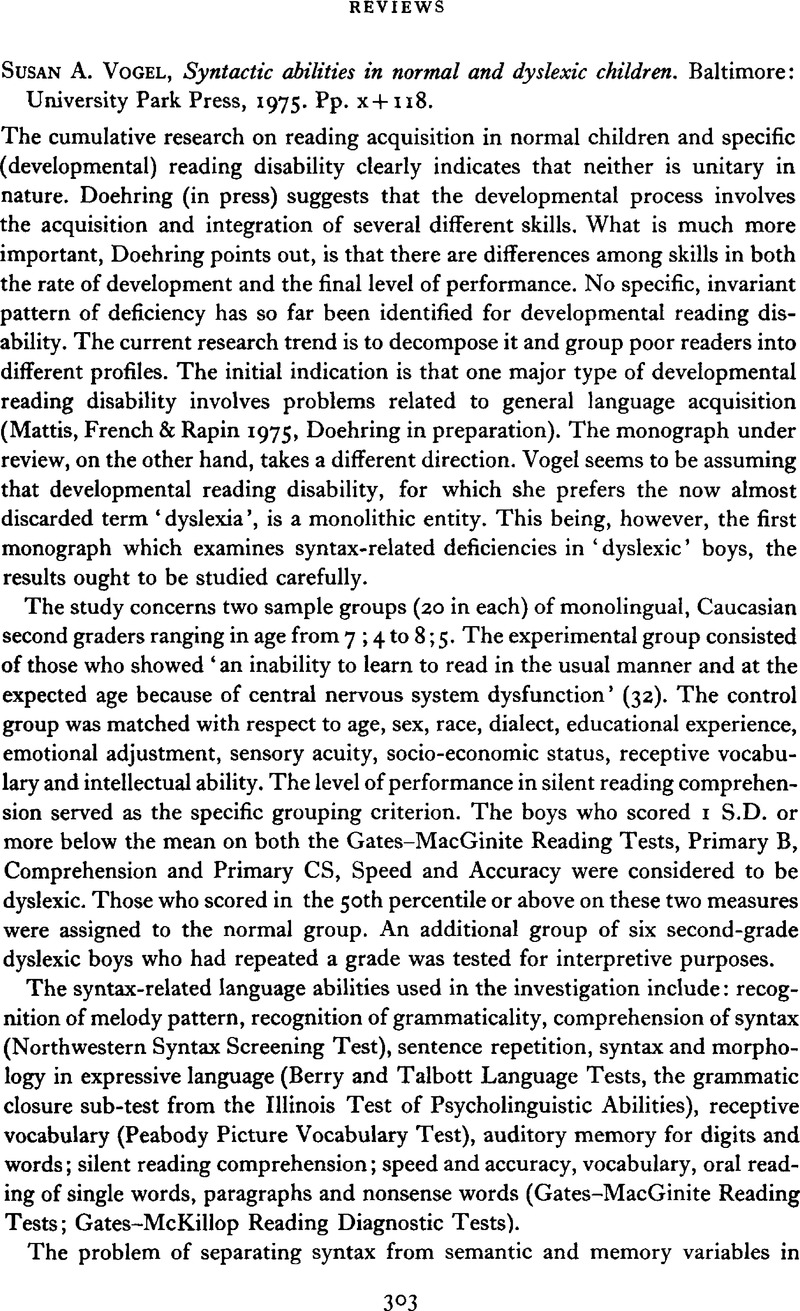No CrossRef data available.
Article contents
Published online by Cambridge University Press: 26 September 2008
Abstract
An abstract is not available for this content so a preview has been provided. Please use the Get access link above for information on how to access this content.

- Type
- Reviews
- Information
- Copyright
- Copyright © Cambridge University Press 1976
References
REFERENCES
Benson, D. F. & Geschwind, N. (1969). The alexias. In Winken, P. J. & Bruyn, G. W. (eds), Handbook of clinical neurology. Vol 4: Disorders of speech, perception and symbolic behaviour. Amsterdam: North-Holland.Google Scholar
Chomsky, C. (1969). The acquisition of syntax in children from five to ten. Cambridge, Mass.: M.I.T.Google Scholar
de Hirsch, K. (1967). Differential diagnosis between aphasic and schizophrenic language in children. JSHD 32. 3–11.CrossRefGoogle ScholarPubMed
Doehring, D. G. (in press). Acquisition of rapid reading responses. Monogr. Soc. Res. Ch. Devel.Google Scholar
Doehring, D. G. (in preparation). Analysis of reading problems in children with communication disorders.Google Scholar
Hécaen, H. (1967). Aspects des troubles de la lecture (alexie) au cours des lésions cérébrales en foyer. Word 23. 265–87.CrossRefGoogle Scholar
Kessel, F. (1970). The role of syntax in children's comprehension from age six to twelve. Monog. Soc. Res. Ch. Devel. 139.Google Scholar
Lowe, A. D. & Campbell, R. A. (1965). Temporal discrimination in aphasoid and normal children. JSHR 8. 313–14.CrossRefGoogle ScholarPubMed
Luria, A. R. (1970). Traumatic aphasia: Its syndromes, psychology and treatment. The Hague: Mouton.CrossRefGoogle Scholar
Luria, A. R. (1973). The working brain: An introduction to neuropsychology. Harmondsworth: Penguin.Google Scholar
Luria, A. R. (1976). Two kinds of disorders in the comprehension of grammatical constructions. Linguistics 47–56.Google Scholar
Mattis, S., French, J. H. & Rapin, I. (1975). Dyslexia in children and young adults: three independent neuropsychological syndromes. DevMedChNeurol 17. 150–63.Google Scholar
Newfield, M. U. & Schlanger, B. B. (1968). The acquisition of English morphology by normal and educable mentally retarded children. JSHR 11. 693–706.CrossRefGoogle ScholarPubMed
Patel, P. G. (1976). The left parieto-temporo-occipital junction, semantic aphasia and language development around age seven. Paper presented at McGill University,School of Human Communication Disorders.Google Scholar
Sklar, B., Hanley, J. & Simmons, W. W. (1972). An EEG experiment aimed toward identifying dyslexic children. Science 240. 414–16.Google ScholarPubMed
Tallal, P. & Piercy, M. (1974). Developmental aphasia: rate of auditory processing and selective impairment of consonant perception. Neuropsychologicl 12. 83–93.CrossRefGoogle ScholarPubMed
Trites, R. L. & Fiedorowicz, C. (in press). Follow-up study of children with specific (or primary) reading disability. In Knights, R. M., & Bakker, D. J. (eds), Neuropsychology of learning disorders: theoretical approaches. Baltimore: University Park Press.Google Scholar
Whyte, S. H.(1965). Evidence for a hierarchical arrangement of learning processes. In Lipsitt, L. P. & Spiker, C. C. (eds), Advances in child development and behavior. Vol. 2. New York: Academic Press.Google Scholar




